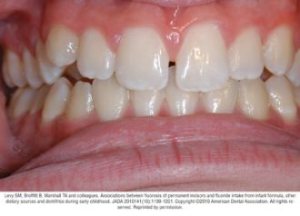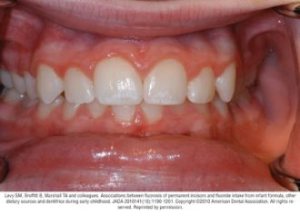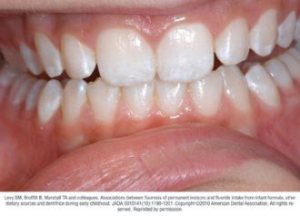Fluorosis

CEREC30 Symposium in Las Vegas
September 28, 2015
Biological & Holistic Dentistry
October 8, 2015Fluorosis
 Dr. Prashant Rao, DDS, a Charlotte native and NYU-trained dentist, specializes in esthetics, dental implants, and preventative dentistry.
Dr. Prashant Rao, DDS, a Charlotte native and NYU-trained dentist, specializes in esthetics, dental implants, and preventative dentistry.
Dental fluorosis is the appearance of faint white lines, spots or streaks on the teeth that only occurs when younger children consume too much fluoride, from any source, over long periods when teeth are developing under the gums. Once teeth break through the gums, you cannot develop fluorosis.
Fluorosis isn’t a disease and doesn’t affect the health of your teeth. In most cases, the effect is so subtle that only a dentist would notice it during an examination. The type of fluorosis found in the United States has no effect on tooth function and may make the teeth more resistant to decay.
Below are four typical cases of mild fluorosis, seen in children participating in the Iowa Fluoride Study.
What Can I Do to Prevent My Child From Developing Fluorosis?
The chance of developing fluorosis exists until about age eight because teeth are still forming under the gums. Ultimately, getting the right amount of fluoride is best—not too much and not too little. Your dentist, pediatrician or family physician can help you determine the proper amount of fluoride for your child. Here are some things parents can do at home to help prevent fluorosis:
Infant to 3 Years Old:
- Breast feed your child. The American Academy of Pediatrics recommends human milk for all infants (except for the few for whom breastfeeding is determined to be harmful). Breast milk is very low in fluoride. Nursing mothers or pregnant women who drink fluoridated water do not pass significant amounts of fluoride to their child.
- If your baby is primarily fed infant formula, using water with fluoride might increase the chance for mild enamel fluorosis. Still, it is safe to use water with fluoride, as enamel fluorosis does not affect the health of your child or the health of your child’s teeth.
- Use powdered or liquid concentrate formula mixed with water that either is fluoride-free or has low concentrations of fluoride. These bottled waters are labeled as de-ionized, purified, demineralized, or distilled.
- Use ready-to-feed formula. This type of formula contains little fluoride and does not contribute significantly to the development of mild dental fluorosis. Consult your doctor on the best type of formula for your baby.
- When your child’s teeth start coming in, brush them thoroughly twice a day (morning and night) or as directed by a dentist or physician.
- Supervise children’s brushing to ensure that they use of the appropriate amount of toothpaste, which is no more than a smear or the size of a grain of rice.
3-8 Year Olds:
- Continue brushing teeth thoroughly twice a day or as directed by a dentist or physician.
- For children ages 3-6, use no more than a pea-sized amount of fluoride toothpaste.
- Many cases of fluorosis can be prevented by keeping children from swallowing fluoride products like toothpaste. Keep an eye on your child’s brushing to help minimize the amount of toothpaste that gets swallowed.
- Do not use fluoride mouth rinses for children under six unless advised to do so by a dentist or other health professional. The American Dental Association does not recommend them at this age because many children younger than six haven’t fully developed their swallowing reflex and may swallow more than they spit out.
- Under the Safe Drinking Water Act, the U.S. Environmental Protection Agency requires public water systems to notify its customers if the natural occurring fluoride level exceeds 2.0 mg/L or parts per million. People living in areas where naturally occurring fluoride levels in drinking water exceed 2 parts per million should consider an alternative water source or home water treatments to reduce the risk of fluorosis for young children.
- While the EPA does not have the authority to regulate private drinking water wells, it recommends that private well water be tested once a year. If you home is hooked up to a private well, it’s a good idea to have the well tested for the fluoride level yearly especially if there are young children in the home. Naturally occurring fluoride levels can vary greatly from location to location. Provide your dentist and physician with the results of the well water testing so that they can provide you with accurate information on your family’s fluoride needs.
- Use dietary fluoride supplements only as prescribed by a physician or a dentist. Fluoride supplements are recommended for children between 6 months and 16 years old living in non-fluoridated areas and at high risk of developing tooth decay. The prescription should follow the dietary fluoride supplement schedule approved by the ADA, the American Academy of Pediatrics and the American Academy of Pediatric Dentistry.
From: ADA Mouth Healthy
Our practice offers a way to remedy fluorosis with a dental treatment called “Icon”. It infiltrates demineralized areas of teeth and removes the appearance of white spots or streaks. Contact us to see if you or your child are a candidate for the Icon dental treatment.
Practice Recognitions
Recent Posts
- How Long Do Same-Day Crowns Last?
- Top Cosmetic Dental Procedures: Start 2025 With a New Smile
- What is a Zirconia Crown
- How To Know If You Need a Root Canal
- Invisalign FAQ: Your Top Questions Answered!
- Invisalign vs. Smile Direct: What Is The Difference?
- Itchy Gums: Causes, Relief, and Prevention
- The Benefits of Dental Implant Surgical Guides
- Wisdom Teeth Removed: 5 Signs You May Need to Remove Yours
- Tips For Wisdom Teeth Pain Relief: All You Need To Know








